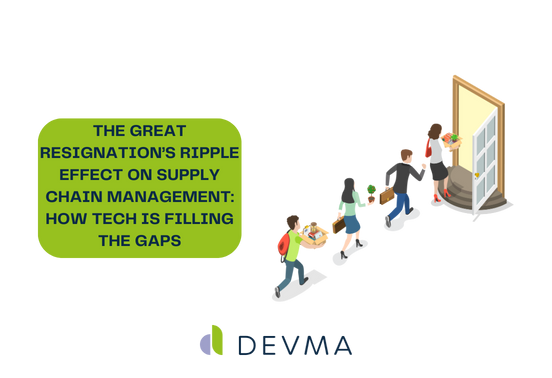Last update: Nov 26, 2024
The Great Resignation’s Ripple Effect on Supply Chain Management: How Tech is Filling the Gaps

Table of contents
- Impact of the Great Resignation: How Technology Filled the Gaps
- Automation: Getting It Done With Fewer Hands
- AI and Predictive Analytics
- Inventory Management Systems
- Digital Twins
- Blockchain
- Why Supply Chain Automation is Essential Post-Resignation
- Supply Chain Automation After the Great Resignation
- The Bottom Line: Tech as the New Backbone
Here’s a nightmare scenario: It’s Monday morning, and you’re staring at an operations dashboard full of red flags. You can’t fulfill your orders because your team is occupied trying to plug the leaks of the Great Resignation. This hit the supply chain square in the face. And for many people, this wasn’t just a scenario—but a reality they lived through in 2021. Massive amounts of people voluntarily quit their jobs, and that’s not even mentioning the folks who got laid off. What ended up happening was technology swooped in to patch up these gaps and keep things moving along, filling in where people once stood. And though the Great Resignation is largely over, the tech solutions that redefined supply chain management are here to stay.
Impact of the Great Resignation: How Technology Filled the Gaps
When people left, tech stepped in. Automation and advanced supply chain management solutions allowed companies to remain operational and meet demand. It’s almost miraculous, but it just goes to show the power of these tools. From new warehouse mechanical robots to AI-driven forecasting, here’s how tech is taking over where manual labor left off:
Automation: Getting It Done With Fewer Hands
Automation isn’t just about getting things done; it’s about getting them done faster and with fewer hands on deck. Think innovations like robotic sorting, automated picking, and self-guided forklifts. For instance, Walmart has unveiled AI-powered warehouses designed to handle perishable goods like meat, dairy, and produce. Their facilities will now utilize automation technology to track inventory in near real-time, anticipate customer demand, and improve stocking practices.
AI and Predictive Analytics
If there’s one thing AI is better at than humans, it’s analyzing massive amounts of data very quickly. This takes the guesswork out of planning. And companies are integrating AI tools into their supply chains to analyze data from demand cycles, shipping trends, and global events to forecast supply chain disruptions before they can cause too much internal chaos.
A couple of recent examples: Celonis is helping Mars optimize truck loads, leading to reduced manual efforts and improved efficiency. ThredUp uses AI to enhance item descriptions and improve productivity in distribution centers.
Inventory Management Systems
When labor is hard to come by, it becomes that much more important to keep track of inventory. Smart inventory management systems like RFID tagging and IoT sensors provide a clear, accurate view of stock levels at every moment. This tech makes sure that products are where they’re supposed to be, and if they’re not, it’s flagged fast.
A major corporation, CVS Health, is revamping its distribution system significantly to expedite supply chains and improve profitability. The company has closed three warehouses, automated a key distribution center, and plans to open a new facility for bulkier items in the name of efficient inventory management.
Digital Twins
Digital twins are virtual replicas of physical assets and processes, giving companies a powerful way to model their supply chain in real-time. They let supply chain managers test different scenarios and see what impacts changes might have without ever disrupting the actual operation.
The University of Cambridge is showcasing how the Internet of Things (IoT) and agent-based technologies can be used to automate certain tasks in supply chains. This research demonstrates the feasibility of autonomous supply chains, allowing companies to simulate and optimize operations without physical trials.
Blockchain
When every hand in the supply chain isn’t as available as it once was, ensuring transparency and trust is vital to the health of any operation. Blockchain technology can track a product’s journey from manufacturing to delivery, recording each handoff securely and providing a clear record of movement.’
Why Supply Chain Automation is Essential Post-Resignation
Though the Great Resignation is over, it has taught us a harrowing and well-needed lesson. The supply chain needs to be supported on many fronts, not just the human one. In the case of a thoroughly gutted workforce, companies should be able to close the gaps if necessary. New tech tools allow teams to work better together, with or without the full staff. It’s not about replacing people with mechanical parts, but rather empowering the people still around to do their jobs better, smarter, and more securely. Because the people who stay around deserve your support.
Supply Chain Automation After the Great Resignation
Labor shortages ended up impacting nearly every part of the supply chain, from manufacturing and logistics to last-mile delivery. The strain left companies scrambling to fulfill demand while avoiding disruptions. In many cases, it’s forced organizations to adopt a more resilient, tech-driven approach to manage the workload with fewer people.
The silver lining for supply chain managers today is that the technological strides made during COVID have done a bang up job future-proofing the industry for the foreseeable future.
The Bottom Line: Tech as the New Backbone
Tech stepped up during COVID and has been rewarded with the role of silent partner in today’s supply chain operations. It bridged the gaps left by the reduced workforce and made sure systems today don’t skip a beat. So much so, that these tools have quickly become irreplaceable. And with these tools, companies can face the challenges of a future Great Resignation-level event not with panic, but with a solid plan, ready to adapt and thrive.
In short, the future of the supply chain looks tech-powered, resilient, and—believe it or not—better equipped to handle change than ever before.